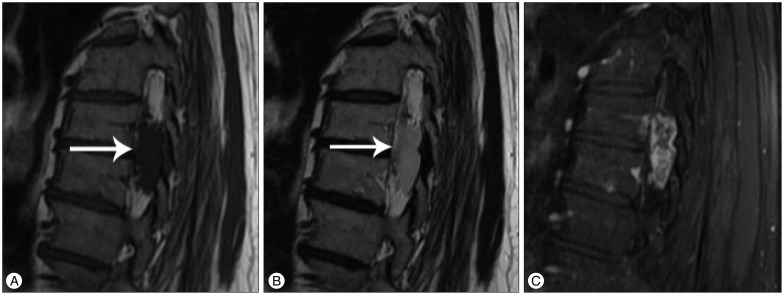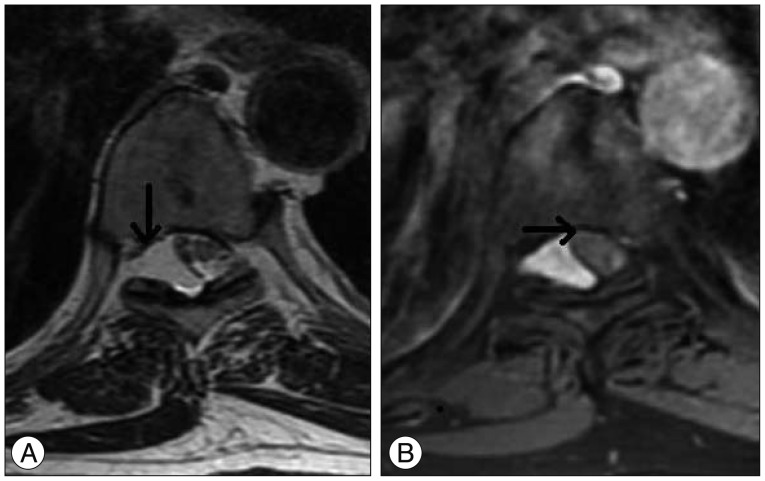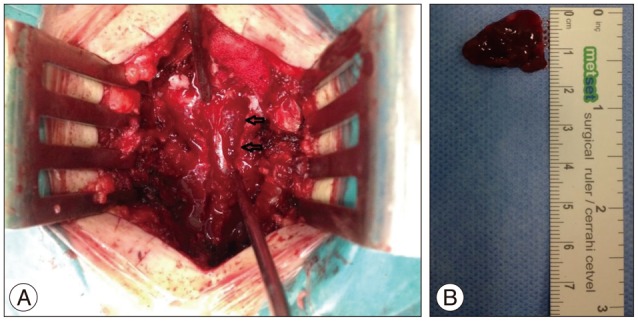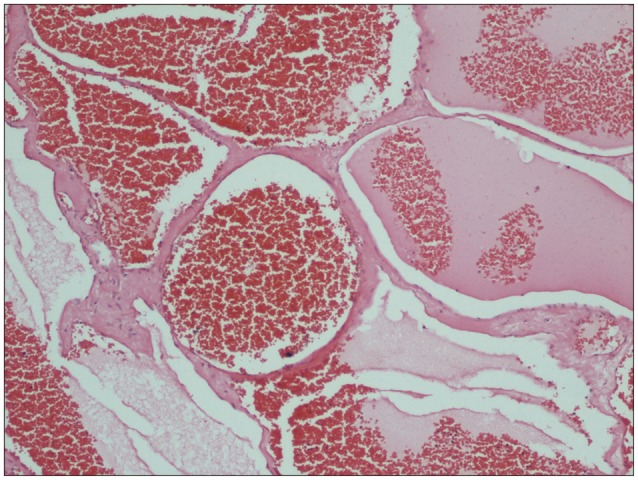J Korean Neurosurg Soc.
2015 Jan;57(1):65-67. 10.3340/jkns.2015.57.1.65.
Thoracic Extraosseous Epidural Cavernous Hemangioma
- Affiliations
-
- 1Department of Neurosurgery, Sakarya Training and Research Hospital, Sakarya, Turkey. drcanyaldiz@yahoo.com
- 2Department of Radiology, Sakarya Training and Research Hospital, Sakarya, Turkey.
- 3Department of Pathology, Sakarya Training and Research Hospital, Sakarya, Turkey.
- KMID: 2067095
- DOI: http://doi.org/10.3340/jkns.2015.57.1.65
Abstract
- Cavernous hemangiomas were first reported in 1929 by Globus and Doshay, and are defined as benign vascular structures developed between the neural tissues occurring in the central nervous system, consisting of a dilated vascular bed. Cavernous hemangiomas comprise nearly 5-12% of all spinal vascular malformations; however, existence in the epidural space without bone involvement is rare. Only 4% of all cavernous hemangiomas (0.22/1.000.000) are purely epidural cavernous hemangiomas. In this case report, we removed a hemorrhagic thoracic mass presenting with progressive neurological deficits in a 55-year-old male patient. We found this case to be appropriate for presentation due to the rare occurrence of this type of cavernous hemangioma.
MeSH Terms
Figure
Reference
-
1. A L H, T R, Chamarthy NP, Puri K. A pure epidural spinal cavernous hemangioma-with an innocuous face but a perilous behaviour!! J Clin Diagn Res. 2013; 7:1434–1435. PMID: 23998084.2. Babu R, Owens TR, Karikari IO, Moreno J, Cummings TJ, Gottfried ON, et al. Spinal cavernous and capillary hemangiomas in adults. Spine (Phila Pa 1976). 2013; 38:E423–E430. PMID: 23354109.
Article3. Feng J, Xu YK, Li L, Yang RM, Ye XH, Zhang N, et al. MRI diagnosis and preoperative evaluation for pure epidural cavernous hemangiomas. Neuroradiology. 2009; 51:741–747. PMID: 19588130.
Article4. Globus JH, Doshay LJ. Venous dilatations and other intraspinal vessel alterations, including true angiomata, with signsand symtoms of cord compression. A report of four cases with areview of the literature. Surg Gynecol Obstet. 1929; 48:345–366.5. Hegde A, Mohan S, Tan KK, Lim CC. Spinal cavernous malformations : magnetic resonance imaging and associated findings. Singapore Med J. 2012; 53:582–586. PMID: 23023898.6. Khalatbari MR, Abbassioun K, Amirjmshidi A. Solitary spinal epidural cavernous angioma : report of nine surgically treated cases and review of the literature. Eur Spine J. 2013; 22:542–547. PMID: 23053760.
Article7. Park ES, Park JS, Kim E. Spinal epidural cavernous angioma : a case report. Korean J Spine. 2008; 5:99–101.8. Sharma MS, Borkar SA, Kumar A, Sharma MC, Sharma BS, Mahapatra AK. Thoracic extraosseous, epidural, cavernous hemangioma : case report and review of literature. J Neurosci Rural Pract. 2013; 4:309–312. PMID: 24250167.9. Shin JH, Lee HK, Rhim SC, Park SH, Choi CG, Suh DC. Spinal epidural cavernous hemangioma : MR findings. J Comput Assist Tomogr. 2001; 25:257–261. PMID: 11242225.
- Full Text Links
- Actions
-
Cited
- CITED
-
- Close
- Share
- Similar articles
-
- Two Cases of Epidural Cavernous Hemangioma in the Thoraic Spine
- Spinal Epidural Cavernous Hemangioma of the Upper Thoracic Vertebrae: Case Report
- Thoracic Epidural Cavernous Hemangioma
- Pure Epidural Cavernous Hemangioma in Thoracic Region: A Case Report
- Pure Spinal Epidural Cavernous Hemangioma with Intralesional Hemorrhage: A Rare Cause of Thoracic Myelopathy





